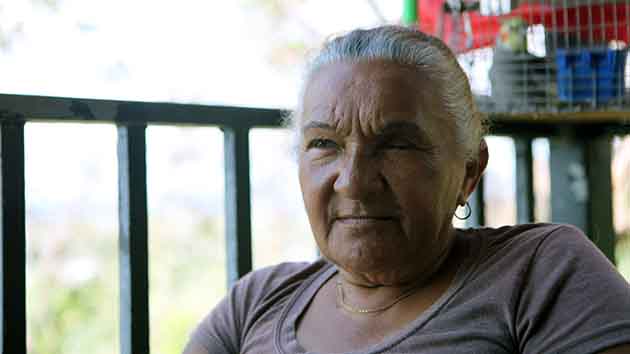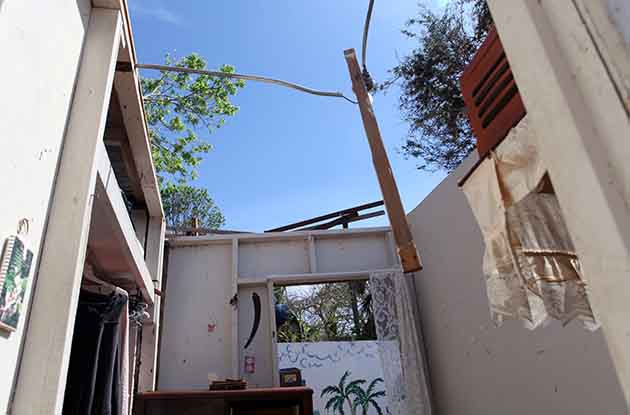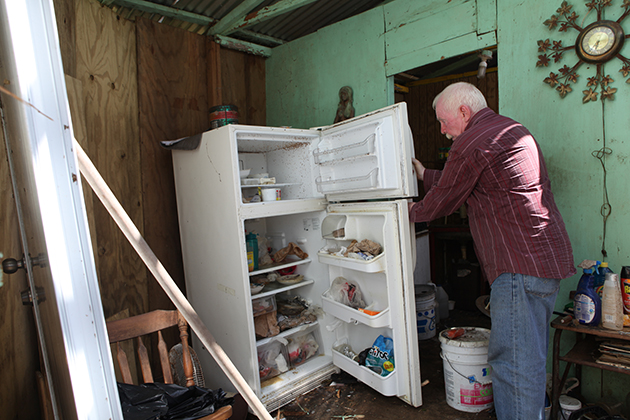Since Hurricane Maria, says Cabo Rojo resident Louis Ramírez, nobody from outside has come to see the devastation in Ballajá, one of the poorest neighborhoods of this town of 50,000 on the southwest coast of Puerto Rico. Up there, “they don’t care if you have medicine, they don’t care if you have anything,” Ramírez tells me and my travel partner, photojournalist Eduardo Meléndez, before hopping in his truck to lead us up the street and show us what he means.
As we wind our way up the hills through Ballajá, we pass electric poles that were snapped in half like twigs during the storm. Many homes show visible damage—roofs are ripped off, and window frames yawn empty.
Ramírez leads us to the home of Rosario Palermo, 66, a woman in need of regular dialysis. Now that her neighborhood has no cellphone connection, she can’t call an ambulance in an emergency, and nobody from the city has responded to her concerns. Instead, the kids from the barrio have to find ways to get her up to Mayagüez—a 20-minute drive that involves navigating downed power poles and using precious gasoline—for medical treatment. “No one will come up here,” Ramírez says.

Rosario Palermo.
AJ Vicens/Mother Jones
Hurricane Maria tore the roof off half of Palermo’s home, exposing her former living room and bedroom to the 95-degree heat and suffocating humidity.

The view from Rosario Palermo’s bed after Hurricane Maria ripped her roof off.
AJ Vicens/Mother Jones
Palermo doesn’t want to talk much about Maria and the condition of her home except to say that she’s decided she’s going to move to the mainland. But Alejandro Santiago Belé, her brother-in-law, who rode out the storm just up the hill at his own house, is eager to tell us about his experience. “It was crazy,” he says, describing how the wind blew up the hill, then swirled where two hills come together, making a loud noise that sounded like nothing he’d ever heard. “My house was shaking, and I thought, ‘This is it.’” Luckily, his home suffered little damage.
Ramírez then leads us down the street to what he says is the home of an old woman who is now staying with relatives. It’s almost completely destroyed. Her soiled belongings fill trash bags in front of the house, which also no longer has a roof. What the neighbors haven’t bagged for her lies soggy and rotting on the floor of the wooden home. He walks over to the refrigerator and tells us, “I’m going to open this fridge once just so you can smell it.” As he flings the door open, food that’s been rotting inside the refrigerator for nearly two weeks gives off a smell that makes all three of us physically recoil. A pack of flies escapes into the hot, damp air.

Louis Ramírez shows us the state of his neighbor’s house, including the rotting food in her refrigerator.
AJ Vicens / Mother Jones
He then points across the street to the half-mile-wide valley below the hill and says that right after the storm, the entire valley was full of water. “It was insane,” he says.
Outside the town’s convention center, where residents are supposed to find help recovering from the hurricane, we meet Wilfred Matos, a 74-year-old Vietnam veteran with thinning white hair and a goatee who moved from California to Cabo Rojo—which is known for its proximity to the island’s best beaches—to retire. “I thought I was going to paradise,” he says. “I was actually going to hell.”
Matos says there’s still no running water, no electricity or gas, and very little food to buy. He says the people inside the convention center took his complaints and told him they’d pass them on to the mayor. I ask him if he trusts the mayor to help him.
“No,” he replies flatly.
Meanwhile, trees have fallen across his partner’s car and house, making staying there extremely dangerous. She has a grown child living with her who needs special care, so she can’t leave. He says he can’t get any cash out of the bank and he’s down to his last $8.
“I wish I never moved here,” he adds, choking back tears.
At City Hall, we find Cabo Rojo’s mayor, Bobby Ramírez Kurtz, in the middle of meeting with local officials about restoring running water in the city. The group of them are standing in the dark, poring over documents using flashlights and light from their cellphones. The mayor, who is responsible for managing recovery from Hurricane Maria for the city’s 50,000 residents, says he’d been running his diesel generator nonstop for 12 days and today it overheated and shut down.
“We’re working on it,” a city worker tells me, holding a cellphone in one hand and a walkie-talkie in the other. “We haven’t closed the City Hall [this whole time].”
To hear the mayor tell it, he’s in the same impossible situation as other city leaders around the island: forced to run recovery operations with little help or coordination from the Puerto Rican or federal government. He says a FEMA representative visited him for the first time last Thursday—more than a week after the storm—and yesterday another woman from FEMA came to assess the medical needs of the town’s residents. The Red Cross finally made it to his town today with a truck full of supplies that he’ll now start handing out to the most vulnerable in town.
A FEMA spokesperson tells me that the agency established a permanent point of contact based in nearby Mayagüez last week, and that “five shipping containers with commodities” were delivered to the town today, for distribution tonight by eight area mayors. The spokesperson added that FEMA has established contact with all 78 mayors in Puerto Rico, but are still working to place permanent liaisons in each of the island’s 12 emergency management zones.
During our conversation with Mayor Ramírez Kurtz, we mention some of the angry residents we had talked to. Ramírez rattles off a list of neighborhoods he’s visited since the storm but doesn’t include Ballajá. “Maybe I haven’t gone to every place on Cabo Rojo, and people haven’t seen us,” he says. “But we have to be running around in the cars because there is no communication.”

Bobby Ramírez Kurtz.
AJ Vicens/Mother Jones
Ramírez Kurtz says he is trying to help everybody in the city, so he can lend his city’s “machinery and people to help other towns of Puerto Rico.” He believes that the Puerto Rican and federal government is not doing enough to help—but he’ll do it by himself. “I don’t care what I have to do to get the things for my people.”
But, I ask, what about President Donald Trump’s claim the federal workers sent are “doing a fantastic job”?
“President Trump hasn’t come down here and seen what’s going on,” Ramírez Kurtz responds. “The people from FEMA just got here last week.”
What else do you want to know about the crisis in Puerto Rico? AJ is taking your questions while he reports from the island. You can submit them here, and he’ll see what he can investigate for you.













